
Attalea maripa, commonly called maripa palm is a palm native to tropical South America and Trinidad and Tobago. It grows up 35 m (115 ft) tall and can have leaves or fronds 10–12 m (33–39 ft) long. This plant has a yellow edible fruit which is oblong ovoid and cream. An edible oil can be extracted from the pulp of the fruit and from the kernel of the seed.

Guadua is a Neotropical genus of thorny, clumping bamboo in the grass family, ranging from moderate to very large species.
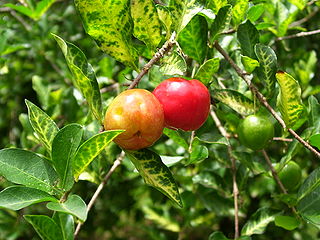
Malpighia is a genus of flowering plants in the nance family, Malpighiaceae. It contains about 45 species of shrubs or small trees, all of which are native to the American tropics. The generic name honours Marcello Malpighi, a 17th-century Italian physician and botanist. The species grow to 1–6 m (3.3–19.7 ft) tall, with a dense, often thorny crown. The leaves are evergreen, simple, 0.5–15 cm (0.20–5.91 in) long, with an entire or serrated margin. The flowers are solitary or in umbels of two to several together, each flower 1–2 cm (0.39–0.79 in) diameter, with five white, pink, red, or purple petals. The fruit is a red, orange, or purple drupe, containing two or three hard seeds. M. emarginata is cultivated for its sweet and juicy fruits, which are very rich in vitamin C.
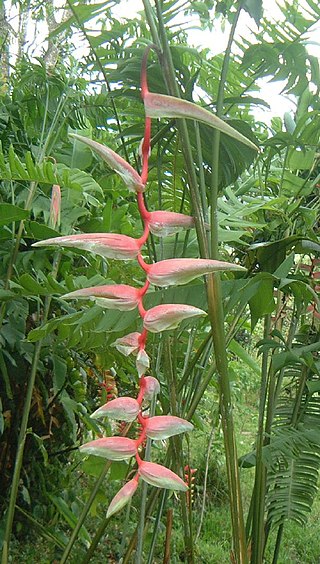
Heliconia chartacea is a species of Heliconia native to tropical South America.

Muntingia is a genus of plants in the family Muntingiaceae, comprising only one species, Muntingia calabura, and was named in honour of Abraham Munting. It is native to the Neotropics, from Mexico south to Bolivia and Argentina, with edible fruit, and has been widely introduced in other tropical areas.

Dalechampia dioscoreifolia is a species of plant in the family Euphorbiaceae first described in 1841. It is native to Central America and northern and western South America.
Thoracocarpus is a genus of plants first described as a genus in 1958. It contains only one known species, Thoracocarpus bissectus a hemiepiphytic vine. It is native to Costa Rica, Panama, Cuba, Trinidad and Tobago, and South America.

Sievekingia is a genus of orchid, comprising 20 species found in Central and South America, from Nicaragua east to the Guianas and south to Bolivia.
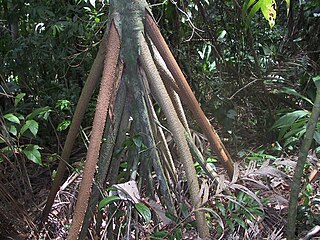
Socratea is a genus of five species of palms found in tropical Central America and South America.

Ficus insipida is a common tropical tree in the fig genus of the family Moraceae growing in forest habitats along rivers. It ranges from Mexico to northern South America.
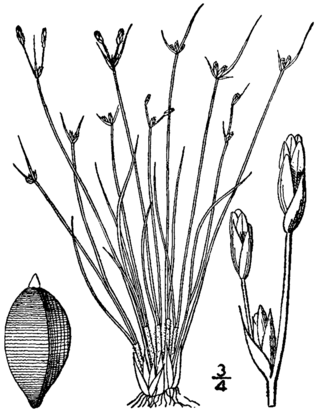
Bulbostylis capillaris is a species of sedge known by the common names densetuft hairsedge and threadleaf beakseed. It is native to much of North America, South America and the West Indies from Canada to Bolivia.
Streptostachys is a genus of South American plants in the grass family.
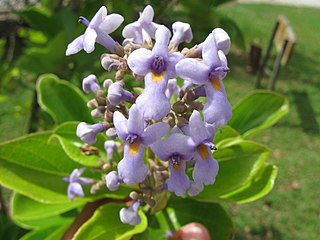
Cornutia is a genus of plants in the family Lamiaceae, first described in 1753. Species in this genus are native to tropical parts of the Western Hemisphere, including southern Mexico, Central America, the West Indies, and northern South America.
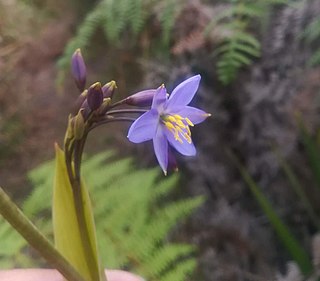
Excremis is a genus of herbs in the family Asphodelaceae, first described as a genus in 1829. There is only one known species, Excremis coarctata, native to South America.

Evodianthus is a genus of plants first described as a genus in 1857. It contains only one known species, Evodianthus funifer, native to Trinidad & Tobago, Central America and northern South America.

Odontadenia is a genus of plant in the family Apocynaceae, first described as a genus in 1841. It is native to southern Mexico, Central America, South America, and the West Indies.
- Odontadenia anomala(Van Heurck & Müll.Arg.) J.F.Macbr. - Peru, Bolivia
- Odontadenia campanulataJ.F.Morales - Colombia
- Odontadenia funigeraWoodson - Venezuela, Colombia, Ecuador, Peru, Brazil
- Odontadenia geminata(Hoffmanns. ex Roem. & Schult.) Müll.Arg. - 3 Guianas, Venezuela, Colombia, Ecuador, Peru, Bolivia, N Brazil
- Odontadenia glaucaWoodson - Amazonas State in S Venezuela
- Odontadenia gracilipes(Stadelm.) Woodson - Minas Gerais
- Odontadenia hypoglauca(Stadelm.) Müll.Arg. - Bolivia, Brazil
- Odontadenia killipiiWoodson - French Guiana, Venezuela, Colombia, Ecuador, Peru, N Brazil
- Odontadenia kochiiPilg. - Guyana, Venezuela, Colombia, Ecuador, Peru, N Brazil
- Odontadenia laxiflora(Rusby) Woodson - Peru, Bolivia, N Brazil
- Odontadenia lutea(Vell.) Markgr. - Peru, Bolivia, Brazil
- Odontadenia macrantha(Roem. & Schult.) Markgr. - Oaxaca, Chiapas, Central America, Trinidad & Tobago, 3 Guianas, Venezuela, Colombia, Ecuador, Peru, Brazil
- Odontadenia markgrafianaJ.F.Morales - French Guiana, N Brazil
- Odontadenia matogrossanaJ.F.Morales - Goiás, Mato Grosso
- Odontadenia nitida(Vahl) Müll.Arg. - Trinidad & Tobago, 3 Guianas, Venezuela, Colombia, Ecuador, Peru, Brazil, Bolivia
- Odontadenia perrottetii(A.DC.) Woodson - Venezuela, Colombia, Brazil, Bolivia, Guyana, French Guiana
- Odontadenia polyneura(Urb.) Woodson - Hispaniola
- Odontadenia puncticulosa(Rich.) Pulle - Central America, 3 Guianas, Venezuela, Colombia, Ecuador, Peru, Brazil, Bolivia
- Odontadenia stemmadeniifoliaWoodson - Venezuela, Colombia, Ecuador, Peru, Brazil
- Odontadenia verrucosa(Willd. ex Roem. & Schult.) K.Schum. ex Markgr. - 3 Guianas, Venezuela, Colombia, Ecuador, Peru, Brazil, Bolivia, Panama, Costa Rica, Nicaragua
- Odontadenia cuspidataRusby = Mandevilla cuspidata(Rusby) Woodson
- Odontadenia duckeiMarkgr. = Mandevilla pohliana(Stadelm.) A.H.Gentry
- Odontadenia glandulosa(Ruiz & Pav.) K.Schum. = Mandevilla glandulosa(Ruiz & Pav.) Woodson
- Odontadenia macrocalyx(Müll.Arg.) Miers = Tabernaemontana macrocalyxMüll.Arg.
Chromolaena squalida is a South American species of flowering shrub in the family Asteraceae. It is found in Brazil, Paraguay, Bolivia, Peru, Colombia, Venezuela, Guyana, Suriname.
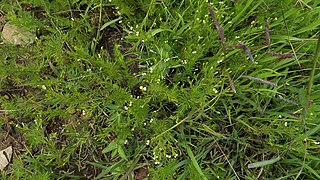
Tagetes filifolia is a New World species of marigolds in the family Asteraceae. It is widespread across much of Latin America from northern Mexico to Argentina. Common name is Irish lace despite the fact that the plant does not grow in Ireland.
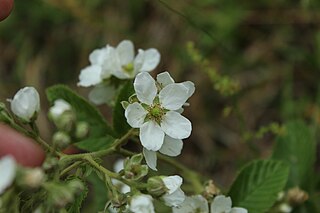
Rubus floribundus is a South American species of brambles in the rose family. It grows in western South America as far south as Bolivia.
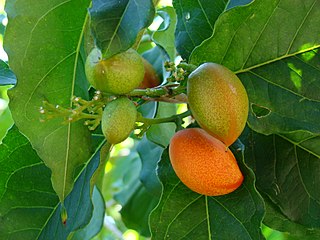
Bunchosia glandulifera, commonly known as peanut butter fruit, is a species of flowering plant in the acerola family, Malpighiaceae, that is native to Central America and South America. It produces small orange-red fruits of sticky and dense pulp, with a flavour and aroma resembling that of peanut butter. It is mostly eaten fresh, but is also used for jellies, jams or preserves. The superficial appearance of the berries are similar to coffee and in Brazil is accordingly called caferana or falso guarana.
















